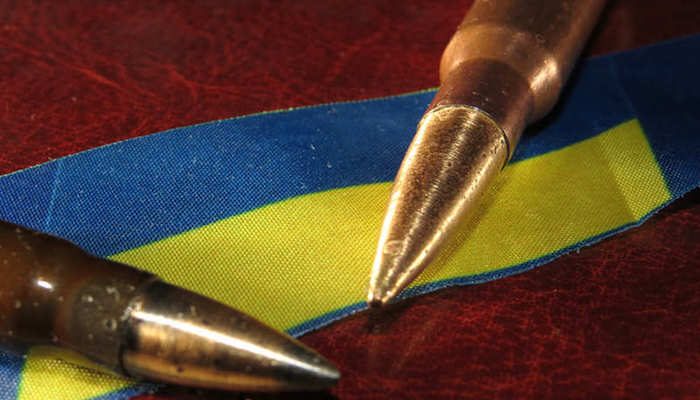
This is an excerpt from Ukraine’s Euromaidan: Broadcasting through Information Wars with Hromadske Radio by Marta Dyczok
Available now on Amazon (UK, USA, Ca, Ger, Fra), in all good book stores, and via a free PDF download. Find out more about E-IR’s range of open access books here
I’ve read a lot about war because I study World War II. Now I find myself in a country that’s experiencing war, a new type of 21st century, post-modern, undeclared, creeping war. My friends in Canada, the US, England, and Brazil, keep writing and asking, “How does it feel? What’s the mood like?”
Being in the capital Kyiv, where spring is in full bloom and the fighting is hundreds of kilometers away, it feels surreal. Every morning I wake up and turn on the news, like I do back home in Canada. The difference here, is that Donets’k, Luhans’k, Crimea, and Moscow are always the top stories.
All around me are people struggling to cope. They lived through the winter Euromaidan protests, where people were attacked, kidnapped, and killed by their own government because they stood up for themselves. They succeeded in ousting a corrupt President, but are now watching as an enemy, hiding behind masks but carrying heavy weaponry, is taking over their territory and killing.
What’s inspiring is seeing people are doing what they can, where they can, and how they can. Journalists are gathering to discuss how to maintain professional standards in conditions of war. Young men are volunteering to go and defend Ukraine’s borders, even though the state is not providing them with proper equipment or training. Activists are buying helmets and bullet proof vests online, bringing them across the border, and sending them to the National Guard.
With war on their territory, perhaps many Ukrainians were not thinking about history on June 22 2014. That day, the anniversary of Germany’s attack on the USSR in 1941, their President Petro Poroshenko visited the current war zone. He placed a wreath at a memorial commemorating those killed in the past, and turned his attention to the present. Announcing a unilateral cease fire, he appealed to those shooting to lay down their arms so that peace could be restored. “Both of my grandfathers died during World War II fighting in the Red Army,” he told reporters, and expressed fears that a new World War might be brewing.
As most Ukrainians hope for peace, the past continues to cast a heavy shadow over the present. The way history was written and taught in the Soviet era distorted the facts and created a warped historical memory in Ukraine and Russia. Those who did not experience events, or have access to independent sources of information, are struggling to come to terms with what actually happened and understand why. Some continue to believe in old myths constructed by all sides.
For decades, people in the Soviet Union were told that the war started on the 22nd of June in 1941. That day Germany launched Operation Barbarossa and invaded the USSR. What wasn’t talked about within the USSR was that the war had actually started in September of 1939 after the Soviet Union and Germany agreed to divide Eastern Europe amongst themselves in the Molotov-Ribbentrop Pact.
This led to the most widespread war in history. It directly involved more than 100 million people from more than 30 countries, and caused between 50 and 85 million fatalities. We may never know the exact figure, but demographers and historians continue to work with statistics and archives. A recent study by Russian historian Vadim Erlikman shows that Ukraine lost over 16% of its population as a result of the war. Of the estimated 6,850,00 killed, 5,200,000 were civilians.
During this conflict a partisan movement sprung up in Western Ukraine that congealed into the Ukrainian Insurgent Army. A significant portion of the fighters came from the Stepan Bandera-led part of the Organization of Ukrainian Nationalists. Their aim was to create an independent Ukraine, but their ideology was right wing and there are some questionable aspects to their activities. They continued to fight for independence into the 1950s and posed a serious threat to the Soviet myth of unity. While demonized in the official Soviet historical narrative, they created their own heroic one.
Today, Russians are being told by their mass media that nationalist-fascists have seized power in Ukraine, that Russians and Russian speakers are being threatened and killed by right wing anti-Semitic banderites, and that the Ukrainian government is killing its own people. These media messages are also being sent into Ukraine. They seem deliberately framed in historical terms to open up old wounds, enflame divisions, and incite hatred.
“The way to stop this war is to stop it in people’s heads,” Donets’k journalist Serhiy Harmash said recently. As a historian I know nothing is ever black or white. But if people take a clear look at the past and confront the truths and the lies, it may help convince those being spurred to kill that they’d be better off building a future.
Further Reading on E-International Relations
- Ukraine and the Russian Challenge to the European Order
- Russia’s War in Ukraine Points to Another Historical Blunder
- Opinion – On 9 May Putin’s Russia Will Glorify War and Stalin
- The Ideas Behind Putin’s War in Ukraine
- Opinion – Rethinking History in Light of Ukraine’s Resistance
- Russia’s War Goals in Ukraine